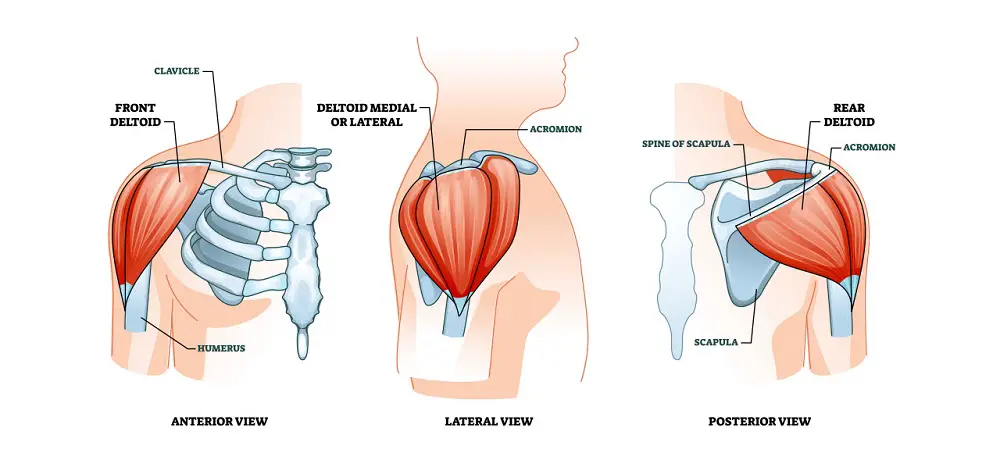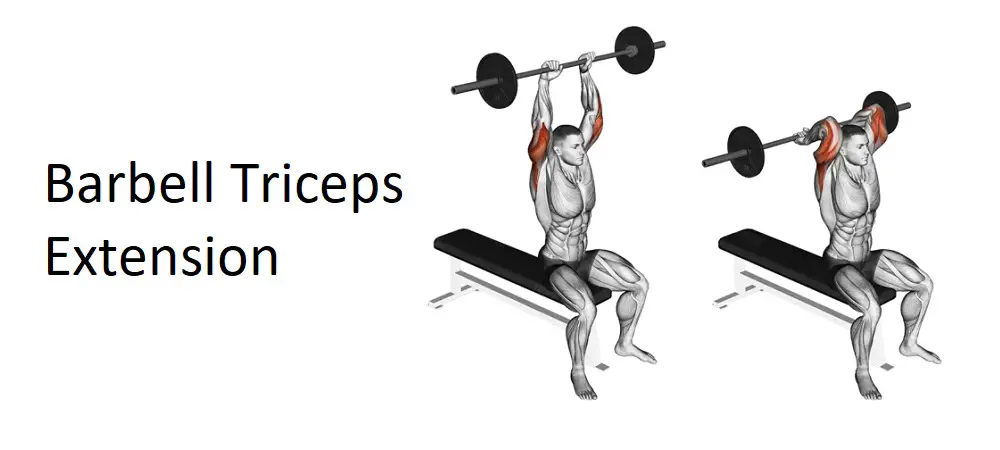Table of Contents
Introduction of Front Delt Exercises
Shoulders are a cornerstone of a well-rounded physique, and among its components, the front deltoids play a significant role in both aesthetics and functionality. Strengthening and defining the front delts not only enhances upper body aesthetics but also contributes to overall shoulder stability and performance in various activities. In this comprehensive guide, we’ll explore a variety of front delt exercises designed to maximize muscle activation, promote growth, and foster shoulder health.
Understanding the Front Deltoids: Before diving into the exercises, it’s essential to understand the anatomy and function of the front deltoids. The front deltoids, scientifically known as the anterior deltoids, are one of the three heads that make up the shoulder muscles. They originate from the clavicle and are inserted into the humerus, allowing for shoulder flexion and horizontal shoulder abduction.
Top Front Delt Exercises:
- Barbell Shoulder Press:
- Description: This compound exercise targets the entire shoulder complex, with a primary focus on the front deltoids.
- Execution: Sit or stand with a barbell positioned at shoulder height. Grip the bar slightly wider than shoulder-width and press it overhead until your arms are fully extended. Lower the bar back to the starting position with control.
- Dumbbell Front Raise:
- Description: Isolating the front deltoids, this exercise helps in developing strength and definition.
- Execution: Stand with dumbbells in each hand, palms facing your body. Keeping a slight bend in your elbows, lift the dumbbells directly in front of you until they reach shoulder height. Lower them back down slowly.
- Arnold Press:
- Description: Named after Arnold Schwarzenegger, this variation of the shoulder press targets the front delts from different angles.
- Execution: Hold a pair of dumbbells at shoulder height with palms facing towards you. Press the dumbbells overhead while simultaneously rotating your palms to face forward. Reverse the motion as you lower the weights back down.
- Cable Front Raise:
- Description: Using a cable machine provides constant tension throughout the movement, maximizing muscle activation.
- Execution: Stand facing the cable machine with the handle attached to the low pulley. Grab the handle with one hand and raise it directly in front of you until your arm is parallel to the floor. Slowly lower it back down and repeat.
- Front Plate Raise:
- Description: This exercise targets the front delts while also engaging the core for stability.
- Execution: Hold a weight plate with both hands in front of your thighs, palms facing inward. Keeping your arms straight, lift the plate directly in front of you until it’s at shoulder height. Lower it back down under control.
Incorporating Front Delt Exercises Into Your Routine: To optimize the benefits of front delt exercises, it’s crucial to incorporate them strategically into your workout routine. Aim to include two to three front delt-focused exercises in your shoulder workouts, ensuring adequate rest and recovery between sessions. Additionally, prioritize proper form and technique to minimize the risk of injury and maximize muscle engagement.
Expanding on the topic, let’s delve deeper into the benefits of Front Delt Exercises, variations to target different aspects of shoulder development, common mistakes to avoid, and tips for maximizing gains.
Benefits of Front Delt Exercises:
- Aesthetic Enhancement: Well-developed front deltoids contribute to the coveted “V-taper” physique, creating the illusion of broader shoulders and a narrower waist.
- Functional Strength: Strong front deltoids improve shoulder stability and mobility, essential for performing everyday tasks and sports-related movements.
- Injury Prevention: Strengthening the front delts helps maintain shoulder joint integrity, reducing the risk of common injuries such as impingement and rotator cuff strains.
- Balanced Muscle Development: By targeting the front deltoids along with other shoulder muscles, you promote balanced muscle growth and symmetry, preventing imbalances that could lead to postural issues.
Variations of Front Delt Exercises:
- Overhead Press Variations: Experiment with different implements like barbells, dumbbells, kettlebells, or resistance bands to vary the stimulus and challenge your muscles from different angles.
- Tempo Training: Manipulate the tempo of your reps (e.g., eccentric, concentric, or isometric phases) to increase time under tension and stimulate muscle growth.
- Unilateral Movements: Perform single-arm variations of front delt exercises to address strength imbalances between your left and right sides and enhance stability.
- Stability Training: Incorporate instability tools like Swiss balls, BOSU balls, or balance boards into your exercises to engage stabilizing muscles and improve joint proprioception.
Common Mistakes and How to Avoid Them:
- Using Excessive Momentum: Avoid swinging or jerking the weight to lift heavier loads, as this reduces muscle activation and increases the risk of injury. Focus on controlled movements and maintain strict form throughout each repetition.
- Neglecting Full Range of Motion: Ensure that you perform exercises through their full range of motion, allowing for maximum muscle engagement and development. Avoid partial reps that limit the effectiveness of the exercise.
- Overlooking Proper Shoulder Alignment: Maintain proper shoulder alignment during exercises to prevent undue stress on the shoulder joints and surrounding structures. Avoid excessive internal rotation or elevation of the shoulders, which can lead to impingement issues.
- Neglecting Warm-Up and Mobility Work: Prioritize warm-up exercises and mobility drills to prepare your shoulders for the demands of training and reduce the risk of injury. Incorporate dynamic stretches, foam rolling, and mobility exercises to improve shoulder flexibility and function.
Tips for Maximizing Gains:
- Progressive Overload: Continuously challenge your muscles by gradually increasing the weight, volume, or intensity of your workouts over time. This progressive approach stimulates muscle growth and adaptation.
- Mind-Muscle Connection: Focus on establishing a strong mind-muscle connection during front delt exercises, consciously engaging and contracting the target muscles with each repetition.
- Recovery and Rest: Allow adequate time for rest and recovery between workouts to facilitate muscle repair and growth. Incorporate rest days into your training schedule and prioritize quality sleep and nutrition for optimal recovery.
- Listen to Your Body: Pay attention to signs of fatigue, soreness, or discomfort, and adjust your training accordingly. Avoid pushing through pain or overtraining, as this can lead to injury and setbacks in your progress.
By incorporating these additional insights into your understanding of front deltoid exercises, you can develop a well-rounded approach to shoulder training that maximizes results and minimizes the risk of injury. Remember to tailor your workouts to your individual goals, abilities, and preferences, and enjoy the process of building strong, sculpted shoulders.
FAQs
What are Front Delt Exercises?
Front deltoid exercises are strength-training movements specifically designed to target the front deltoid muscles, also known as the anterior deltoids. These exercises typically involve shoulder flexion or horizontal shoulder abduction, effectively working the front portion of the shoulders.
Why is it important to train the Front Delt Exercises?
Training the front deltoids is essential for several reasons:
1) Aesthetic Development: Well-developed front deltoids contribute to a balanced and symmetrical shoulder appearance, enhancing overall upper body aesthetics.
2) Functional Strength: Strong front deltoids improve shoulder stability and mobility, supporting various daily activities and athletic movements.
3) Injury Prevention: Strengthening the front deltoids helps maintain shoulder joint integrity, reducing the risk of common injuries such as impingement and rotator cuff strains.
What are some common Front Delt Exercises?
1) Barbell Shoulder Press
2) Dumbbell Front Raise
3) Arnold Press
4) Cable Front Raise
5) Front Plate Raise
These exercises can be performed using various equipment, including barbells, dumbbells, cables, or weight plates.
How often should I train my front deltoids?
The frequency of front deltoid training depends on several factors, including your overall training split, goals, and recovery capacity. As a general guideline, aim to train your front deltoids 1-3 times per week, ensuring adequate rest and recovery between sessions. It’s essential to listen to your body and adjust your training frequency accordingly based on individual needs and responses.
Are there any tips for preventing shoulder injuries during front deltoid exercises?
Yes, here are some tips for preventing shoulder injuries during front deltoid exercises:
1) Warm-up: Prioritize a thorough warm-up routine to prepare your shoulders for exercise, including dynamic stretches and mobility drills.
2) Maintain Proper Form: Focus on maintaining proper shoulder alignment and technique during exercises to prevent undue stress on the shoulder joints.
3) Gradual Progression: Progressively increase the weight or intensity of your workouts over time to avoid overloading the shoulders too quickly.
4) Listen to Your Body: Pay attention to any signs of discomfort or pain during exercise and modify or stop movements accordingly. If you experience persistent or severe pain, seek guidance from a healthcare professional.
By following these guidelines and incorporating proper exercise techniques and injury prevention strategies, you can minimize the risk of shoulder injuries during front deltoid training.
Conclusion
Strong and defined front deltoids not only enhance your physique but also contribute to overall shoulder strength and functionality. By incorporating a variety of front delt exercises into your training regimen and focusing on progressive overload, you can effectively target this crucial muscle group and achieve your strength and aesthetic goals. Remember to listen to your body, prioritize proper form, and enjoy the journey of building powerful shoulders.
If you are interested in reading this in detail you can check Different Shoulder Exercises Affect the Activation of Deltoid Portions in Resistance-Trained Individuals








